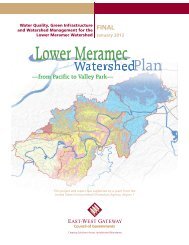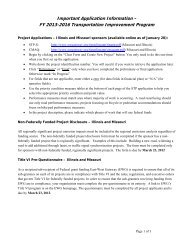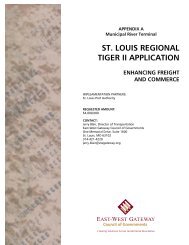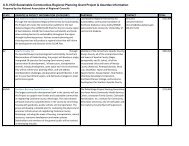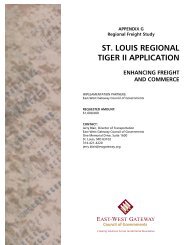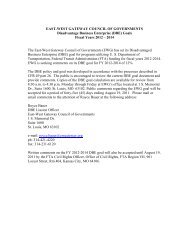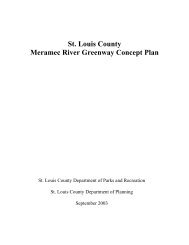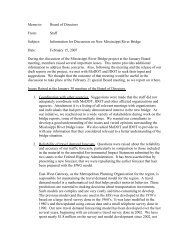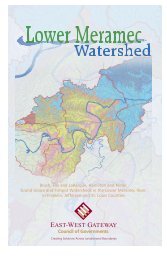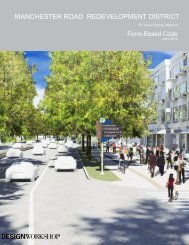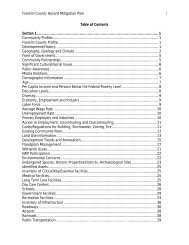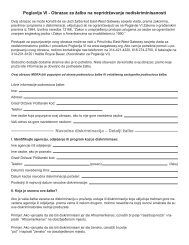St. Charles County Transportation Plan 2030 - East-West Gateway ...
St. Charles County Transportation Plan 2030 - East-West Gateway ...
St. Charles County Transportation Plan 2030 - East-West Gateway ...
You also want an ePaper? Increase the reach of your titles
YUMPU automatically turns print PDFs into web optimized ePapers that Google loves.
taking into account future improvements outlined in the present TIP and Legacy <strong>2030</strong>. Second, the<br />
percent change in population, households, and employment, forecasted by the Council in the five<br />
sections of the county as shown in Figure 1, was related to the growth factors developed for each<br />
road. Third, road characteristics including their functional classifications, lengths, type of areas they<br />
traversed, and number of lanes, were reviewed. Forecasts were then developed for each road in 10<br />
year increments from 2010 to <strong>2030</strong> to allow for close comparison to population, households, and<br />
employment forecasts, and land use changes that are expected.<br />
The forecasts developed by the Council were reviewed with MoDOT staff to insure that they were<br />
in line with their forecasts and any major reports prepared for them. Two such reports were recently<br />
prepared. The first entitled “Interstate 70 Corridor, Second Tier Draft Environmental Impact<br />
<strong>St</strong>atement,” addressed state-wide improvements to I-70 and included the section dealing with<br />
Montgomery, Warren, and <strong>St</strong>. <strong>Charles</strong> Counties. Forecasts of I-70 traffic for <strong>2030</strong> were included<br />
in that study and were reviewed in this report. The second report, entitled “Final Environmental<br />
Impact <strong>St</strong>atement, U.S. Route 40/61 Bridge Location <strong>St</strong>udy over the Missouri River,” contained<br />
<strong>2030</strong> traffic forecasts on I-64 at the bridge. They also were reviewed. No other studies of<br />
MoDOT’s major roads were prepared that would produce future traffic counts.<br />
C-2. Future Traffic Volumes and Travel Conditions on MoDOT Roads<br />
Traffic volume forecasts for <strong>2030</strong> were developed for all roads in functional classification order.<br />
From these forecasts travel conditions or the degree of congestion that can be expected was<br />
determined. MoDOT roads were examined first as they carry the highest volumes of traffic. The<br />
degree of congestion was expressed in Level of Service (LOS) as explained in Chapter III.<br />
Interstates and Freeways are addressed first followed by Principal Arterials, Minor Arterials, and<br />
Major Collectors. The <strong>2030</strong> ADTs are shown in Figures 7, 8, and 9. A complete tabulation of the<br />
traffic volume forecasts for MoDOT’s roads are contained in Appendix B. Using these forecasts,<br />
the number of lanes for each road, and the road improvements shown in the TIP and Legacy <strong>2030</strong>,<br />
the LOS for each road were determined. They were developed by following the procedures in the<br />
2000 HCM described in Chapter III. The result for each road segment is discussed below.<br />
C-2.1. Interstate and Freeways<br />
Interstates and freeways are considered primary roads in <strong>St</strong>. <strong>Charles</strong> <strong>County</strong> and the region. They<br />
handle the highest volumes with no interruption and ingress and egress allowed only at interchanges.<br />
Their design features are almost identical and therefore, they are discussed first.<br />
I-64<br />
ADTs From the Missouri River west to I-70, traffic volumes have continued to increase as new<br />
sections of this road were completed. From 1990 to 2000, before parts of it were upgraded to<br />
Interstate standards, traffic across the Missouri River grew by 56 percent from 44,300 to 69,100.<br />
By 2004, it had climbed to 77,500, and that was with a new bridge across the river on Rt. 364 which<br />
diverted some traffic. By 2010 it is expected that volumes will reach 90,000 and by <strong>2030</strong> are<br />
forecast to rise to 120,000. The Rt. 94/Rt. K interchange will serve considerable traffic and volumes<br />
94



